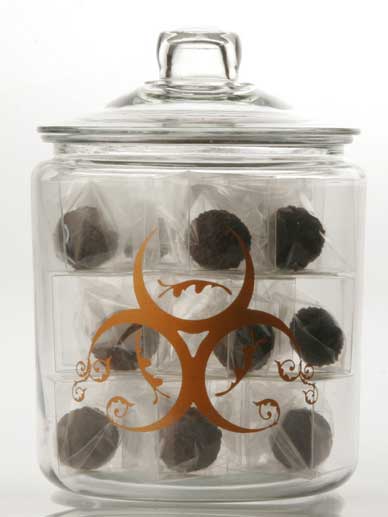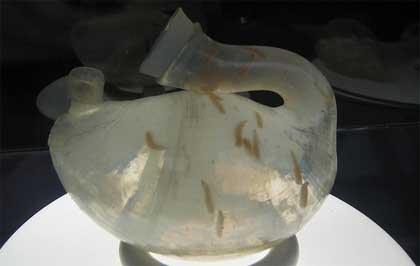Alba: a genetically engineered rabbit with green fluorescent protein by Eduardo Kac
So, what is BioArt? The self-experimentation of a guy who is half-crocked on Busch light, has a homemade tattoo gun and a dream? Well, possibly. But, according to wikipedia (so it must be true), bio art is:
... an art practice in which the medium is living matter and the works of art are produced in laboratories and/or artists’ studios. The tool is biotechnology, which includes such technologies as genetic engineering, tissue culture and cloning. BioArt is considered by most artists to be strictly limited to “living forms,” although there is some debate as to the stages at which matter can be considered to be alive or living. The materials used by Bioartists are cells, DNA, proteins and living tissue. Creating living beings and practicing in the life sciences brings about ethical, social and aesthetic inquiry. http://en.wikipedia.org/wiki/BioArtSo, why BioArt? It is difficult to ascribe one particular source as the impetus which fuels bioartists' creativity or their choices with regards to methods and materials. The innate human drive to create is strong and, by nature, always searching for new and creative ways in which to express ideas. In that sense, BioArt was an inevitable offshoot of the same creative drive that compelled the first humans to draw upon cave walls. Early man created with charcoal and natural pigments, modern man creates with genetically manipulated tissue.
A replica of an ear created by the group, SymbioticA
Furthermore, it can be said--not without argument of course--that art is inseperably entwined with society and will inevitably come to represent the strata of thoughts that a particular society values or is coming to terms with. Art is a good barometer with which to measure the good, the bad, and the ugly of any society.
As our scientific community is currently exploring the new found ability to manipulate the genetic underpinnings of human life, the populi have had little or zero access to the discussion table simply due to the fact that the research is largely inaccessible because of the barriers that are in place. These barriers are: not having the necessary understanding of the materials utilized in the research; not having an understanding of the processes involved; often taking for truth the intentionally manipulated information provided by organizations with an agenda; deliberate barriers set in place by corporate entities for "trade secret" or copyright reasons; and for a host of other reasons that somebody smarter than me could come up with.
Viral Confections: A model of the virus was printed as a rapid prototype from a 3D algorithmic illustration of the virus from the Protein Data Bank. The chocolates were then cast into the molecular form. Part of the Sentimental Objects in Attempts to Befriend a Virus series, the truffles do not carry hepatitis C. Desire to eat them is mixed with a repulsion for the virus, a dialectic which has proved to be an exciting and approachable way to ignite discussion and create awareness about an extremely prevalent and underrepresented disease. http://www.we-make-money-not-art.com/archives/bioart/index.php?page=8
BioArtists provide a venue for the general public to access the otherwise quasimystical and mysterious world of genetic manipulation and bioengineering. Getting the public involved in the discussion--not just repeating the talking points--is critical for a society. To become involved and aware of the issues that the BioArts raise is often the the goal of the bioartist as many people have very little knowledge of the serious bioethical issues that are met and resolved largely behind closed doors in which private interests perhaps win out over public interests.
This video with bioartists Jennifer Willet and Oron Catts discusses some of the issues mentioned above and gives an example of their work:
Concerning answering the question "Why BioArt?" Jennifer Willet's article from her website offers further (and a much more erudite) explanation:
In general, the public holds very little currency in the decision-making processes that dictate research trajectories, evaluation criteria, and the direct application of advancements made in biotechnological sectors. In general, I see the non-specialist public as having a receptive relationship to evolving biotechnologies. In other words, individuals are on the receiving end of a long chain of events contributing to the proliferation of these knowledges and practices in the world – trusting the specialists to manage this aspect of technological proliferation on our behalf. Generally, the public (as well as the specialist class) seems to be content with this arraignment...
...One strategy for combating a programmed public malaise in the face of biotechnology is to effectively trump the authority of the specialist class with the insertion of non-authoritarian individuals into ‘specialist’ rolls in the public sphere. The insertion of visible and intellectual difference into traditional roles of scientific authority can empower the general public to participate more fully in biotechnological debates. I am interested in a participatory interdisciplinary incursion into the practice, and public representation, of biotechnology. If artists, and accountants, and housewives are seen contributing to the production of biotechnology, the authority of the specialist – the doctor, lab technician, and scientist – will be reduced. Alternative voices – subjectivities – and interpretations of biotechnology will be heard and perpetuated in public debate.Well said.
From The Race installation by Michael Burton. Antibiotics underpin all of modern medicine. Alarmingly, we are nearing the end of the antibiotic era. Bacteria and viruses are evolving faster than scientific innovation. Trivial infections we hardly think about now will once again become fatal...Medics now recognise that maggots have advantages over more recent forms of treatment, as they kill the bacteria that cause infection, including the so-called antibiotic-resistant superbugs. The Race proposes that we must now join the race to evolve with them. It also presents a mirror to ourselves to question personal and societal lifestyle practices and our self-perceived superiority over other organisms. http://www.we-make-money-not-art.com/archives/2007/06/michael-burton.php
Although there is certainly a strong desire among many BioArtists to bring the often inaccessible world of the scientific community to the general discussion table, I think that there is another component to the reason that BioArtists work in the media they do. It is simply rewarding to work in the media. Further, it is the first "new" media available in hundreds of years. I can only imagine that some of the Northern Renaissance painters felt similarly when they first got their hands on the new-fangled oil paints. Everything going forward will be uncharted waters--the artist's dream.
To see the works of some BioArtists you can check out the following links:
Jennifer Willet
George Gessert
Joe Davis
Eduardo Kac
Hunter Cole
Oron Catts
Olga Kisseleva





No comments:
Post a Comment